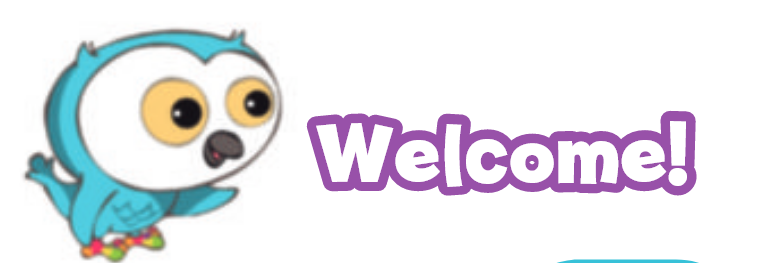

Para que tengáis una idea del vocabulario que trabajamos en cada unidad. Tenéis actividades con este vocabulario en los Recursos digitales de Ollie y es el mismo que aparece en las canciones que usamos:
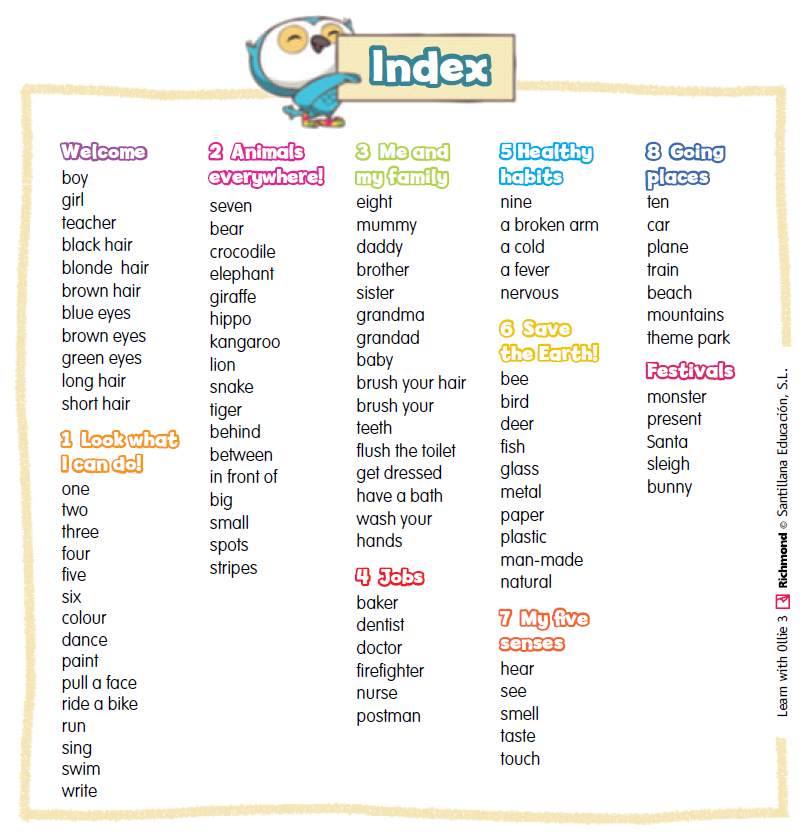
Haz clic en la imagen de las fichas para poder descargarlas 😉
UNIT 1: LOOK WHAT I CAN DO!

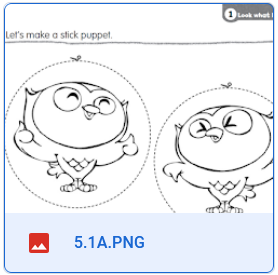
can decorate them with glitter. When the childen have finished, distribute scissors. Tell them to carefully cut out the two circles. Distribute the lolly sticks and glue. Help the children to stick on the lolly stick with sticky tape to one of the circles and to glue the two pictures back to back to make their stick puppet.

colour their stars in and help them to decorate the borders with glitter and glue.
When they have finished, distribute scissors and the strips of construction paper. Tell the children to carefully cut out all the stars. Help them to glue the big star onto the middle of the strip and to glue two small stars on either side. As they finish, tell the children to come to the front of the class and staple the strips to make
headbands. Encourage the children to talk about the things that they drew on their stars.
C: (I can ride a bike).
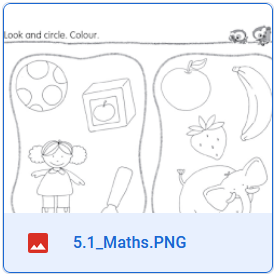
C: The fork. T: That’s right. The fork is different because it’s not a toy. Tell the children to cross out the fork and to colour the toys. Repeat for the second group of pictures. The children
cross out the elephant and colour the fruit.
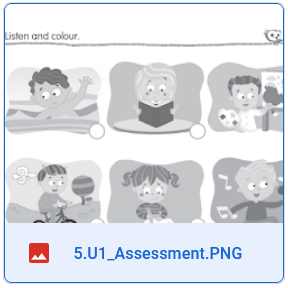
to the girl. Distribute crayons. Tell the children to find the following colours: blue, green, orange, pink, red and yellow. Ask the children to hold
up each colour: T: Show me your blue crayon. Show me your green crayon… Play 1.15 Unit 1 Assessment, pausing the CD after each speaker.
Alternatively, read out the transcript. The children listen and colour the circles according to the instructions. Repeat as many times as necessary. When the children have finished, check their answers. T: Point to the (boy swimming). What colour is the circle? C: It’s (red)!

UNIT 2: ANIMALS EVERYWHERE!
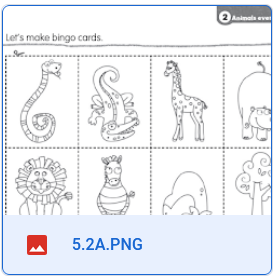
C: It’s a (crocodile). T: Is this a (tree)?
C: No! It’s a (rock). Distribute crayons and ask the children to get the following colours
ready: red, green, brown, yellow, grey and black. Have the children hold up each colour in turn:
T: Show me your (red) crayon. Good.
Now show me your (green) crayon…
Tell the children they are going to make bingo cards. Do a colour dictation. The children listen and colour according to your instructions. Repeat the instructions as many times as necessary
and help any children who need attention.
T: Point to the snake. Find your red crayon. Colour the snake red. Point to the crocodile. Find your green crayon. Colour the crocodile green.
Point to the giraffe. Find your brown crayon and your yellow crayon. Colour the giraffe brown and yellow. Point to the hippo. Find your grey crayon. Colour the hippo grey. Point to the lion. Find your yellow crayon. Colour the lion yellow.
Point to the zebra. Find your black crayon. Colour the zebra black and white. Point to the rock. Find your grey crayon. Colour the rock grey. Point to the tree. Find your green crayon and your brown crayon. Colour the tree green and brown. When the children have finished, distribute scissors. The children
cut out their cards.
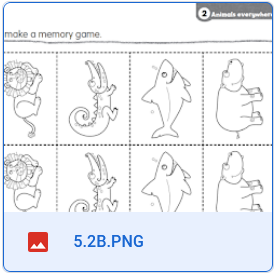
and ask the children if they can name them and if they know
where they live.
T: What’s this?
C: It’s a lion.
T: Does the lion live in the savannah?
C: Yes, it does.
T: What’s this?
C: It’s a shark.
T: Does the shark live in the forest?
C: No! The shark lives in the sea!
Distribute crayons. Ask the children what colour the animals are.
T: What colour is a hippo?
C: Grey.
T: Very good. Find your grey crayon and colour the hippos grey.
Repeat with the remaining animals. When they have finished
colouring, distribute scissors and tell the children to carefully
cut the animal cards out along the dotted lines. Tell
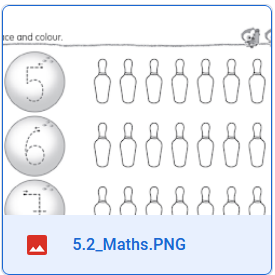
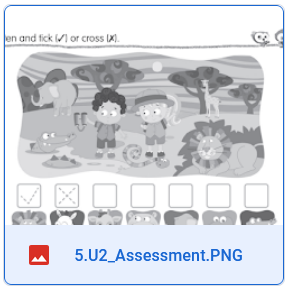
C: No! It’s the savannah.
Ask the children to find their pencils. Model and check the correct
way to hold the pencil, then trace a tick ( ) and a cross ( ), first on
the board and then in the air, to demonstrate the correct formation.
Ask the children to imitate you, tracing the symbols in the air.
Tell the children to look at the big picture again. Point to the small
pictures of the animals and play 1.24 Unit 2 Assessment, pausing
the CD after each speaker. Alternatively, read out the transcript. If
the children can see the animal in the big picture, they draw a tick
in the box. If they cannot see the animal, they draw a cross.
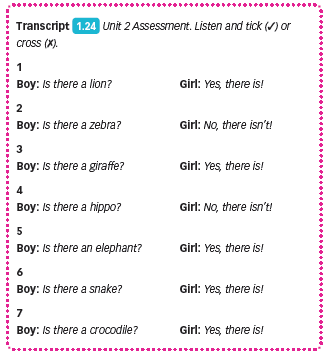
UNIT 3: ME AND MY FAMILY
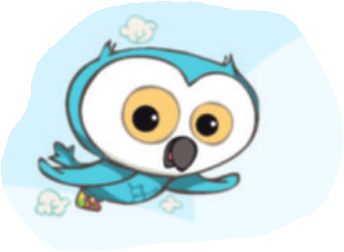
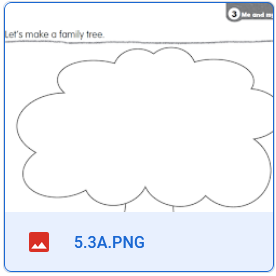
and the leaves of the tree green.
Put the worksheets to one side to dry, then distribute the squares
or circles of blank paper, crayons and glue. Tell the children to draw
pictures of members of their family (from the family members they
have learnt), one face on each piece of paper. When the children
have finished, help them to glue the pictures on their tree painting
to make a family tree.
Call on individual children to show the class their family tree and
encourage them to talk about it.
C: This is (me). This is my (grandad).
The children can take their family trees home. Alternatively, you can
display them in the classroom.

colour in the baby except for the nappy. When they have finished,
distribute the coloured paper and glue. Tell the children to tear up
the paper into small pieces and to stick them on the baby’s nappy.
Distribute scissors and paper fasteners. The children carefully cut
out the baby along the dotted lines. Show them how to fasten
the parts of the body together using paper fasteners and help if
necessary. Next, demonstrate how to position the parts of the body
so that the baby is crawling. Distribute the pieces of wool. The
children glue the wool onto the baby’s head to make hair.
Encourage the children to talk about the babies.
T: What can the baby do? Can the baby run?
C: No, the baby can’t run.

children to look at the keys at the top of the page.
T: What shape is key (six)?
C: A (triangle).
Repeat with the other two keys. The children respond:
‘circle‘, ‘triangle‘ or ‘square‘. Tell the children to look at
the keyholes in the doors of the houses.
T: Which key is for this door?
C: Number (eight).
The children match the keys with the doors and write the
corresponding numbers in the boxes.
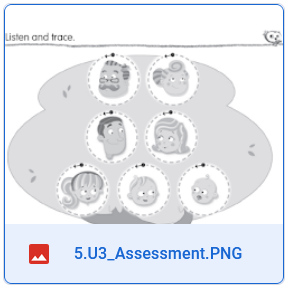
to the pictures in turn.
T: Where’s Mummy? Point to Mummy.
Distribute crayons and ask the children to get the following colours
ready: red, pink, yellow, orange, green, black and blue. Ask the
children to hold up each colour:
T: Show me your (red) crayon. Good. Now show me your (pink)
crayon…
Tell the children that they are going to listen and trace the circles
with different coloured crayons. Play 1.32 Unit 3 Assessment,
pausing the CD after each speaker. Alternatively, read out the
transcript.

EVALUACIÓN 1ER TRIMESTRE:

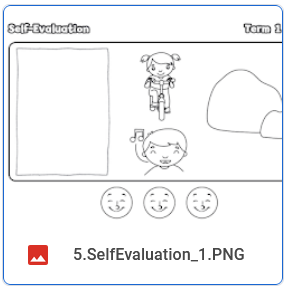
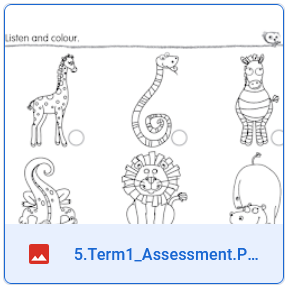
the following colours ready: yellow, green, red, blue, orange and
pink. Tell the children that they are going to listen and colour the
circles with different coloured crayons. Play 2.44 End of Term 1
Assessment, pausing the CD after each speaker. Alternatively, read
out the transcript.

UNIT 4: JOBS
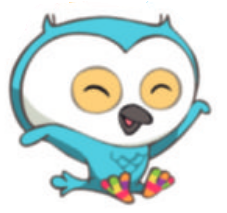
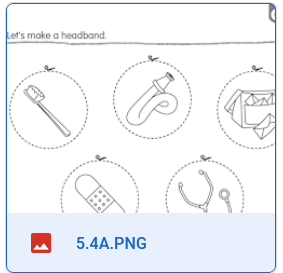
ask the children to name the jobs.
T: Who uses a hose?
C: A firefighter!
T: That´s right!
T: Who uses a bag of letters? (A postman)
T: Who uses a plaster? (A nurse)
T: Who uses a toothbrush? (A dentist)
T: Who uses a stethoscope? (A doctor)
Hand out the scissors. Tell the children that they are going to make
a headband. Get them to choose a job and cut out and colour the
corresponding tool. As the children finish, call them to the front
of the class. Measure the strips of construction paper against the
children’s heads and staple each strip to the correct size. Give each
child a paperclip and show them how to attach the picture of the
tool to the headband. Encourage each child to tell you who they are.
T: Who are you?
C: I’m a (doctor).
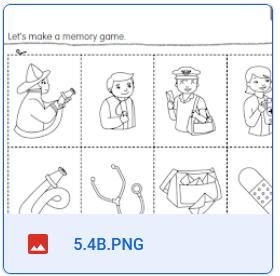
card game. Get them to colour in the pictures of the workers and
the tools using whichever colours they wish.
Hand out one sheet of A4 construction paper to each child,
and then distribute glue and scissors. The children glue the
Photocopiable Worksheet onto the construction paper and then
cut out the people and tools along the dotted lines. Tell them to
write their name on the back of each card.
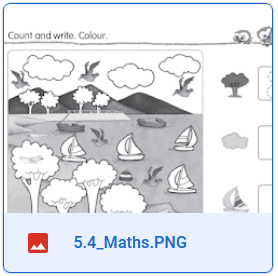
children to look at the pictures on the right hand side
of the page and help them to name the tree, the cloud and
the boat. Count the trees in the big picture together
and tell the children to trace over the number eight. Ask
the children to count the other objects and write the
numbers in the boxes. When they have finished, they can
colour the big picture.

and ask the children to point to them:
T: Where’s the (firefighter)? Point to the (firefighter).
Ask the children to find their pencils. Demonstrate the correct way
to hold the pencil, between the thumb and first finger. Ask them
to hold their pencils up in the air and check they are holding them
correctly. Trace the numbers one to five first on the board and then
in the air, to demonstrate the correct formation. Ask the children to
imitate you, tracing the numbers in the air.
Play 1.40 Unit 4 Assessment, pausing the CD after each speaker.
Alternatively, read out the transcript. The children write the correct
numbers in the boxes.

UNIT 5: HEALTHY HABITS

out the food magazines and scissors then get the children to find
pictures of fruits and vegetables in the magazines and cut them
out. Give both groups a chance to use all the magazines.
When the children have finished, randomly mix the pictures. Hold
them up and encourage the children to say whether the items are
fruits or vegetables.
Hand out the Photocopiable Worksheets, the paper plates and glue.
Tell the children to cut out the circle and stick it on their paper
plate. Distribute the magazine pictures. Tell the children to find
pictures of fruit for the fruit side of their plate and vegetables for
the vegetable side. The children glue the pictures on their plates.
Monitor to make sure that the children stick their pictures in the
correct section and help any children who need assistance.
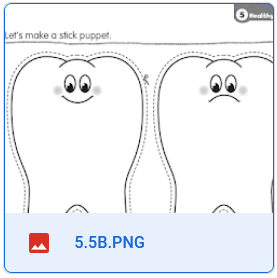
children to draw pictures of things that make our teeth happy
inside the happy tooth and things that make our teeth sad inside
the sad tooth.
When they have finished, distribute the scissors and tell the
children to cut out the two teeth. Distribute the lolly sticks and glue.
Help the children to stick their teeth back to back with the lolly
stick inside to make a stick puppet.
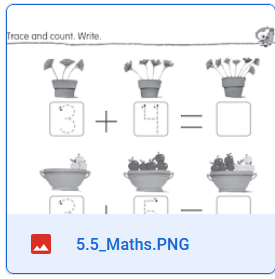
the first pot of flowers and count them with the children.
Tell the children to get out their pencils and trace over
the number three in the box. Repeat with the second pot.
Ask the children to imagine they are going to plant all the
flowers in one pot. How many flowers would there be in
total? Hold up three fingers on one hand and four fingers
on the other hand, then bring them together. Count with
the class. The children count the flowers in the final pot
and write the total in the box.
Repeat the procedure with the bowls of apples.
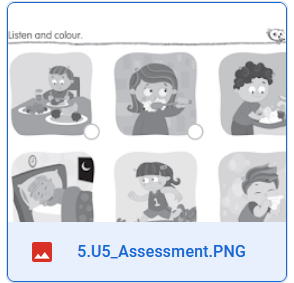
the children’s attention to the pictures. Ask:
T: What are the children doing?
Elicit the vocabulary from the unit: eat healthy food, brush your
teeth, wash your hands, sleep, do exercise, use a tissue.
Distribute crayons and tell the children to get the following colours
ready: red, pink, yellow, orange, green, blue, brown and black. Tell
the children that they are going to listen and colour the circles.
Play 2.8 Unit 5 Assessment, pausing the CD after each speaker.
Alternatively, read out the transcript.
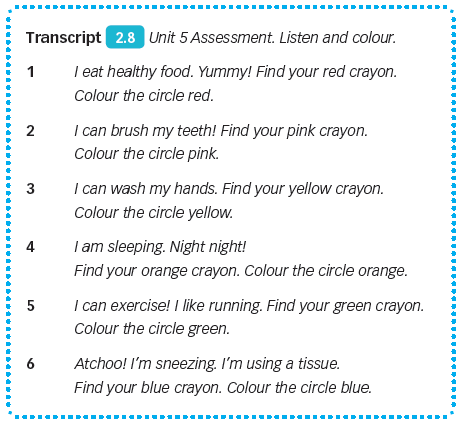
UNIT 6: SAVE THE EARTH!
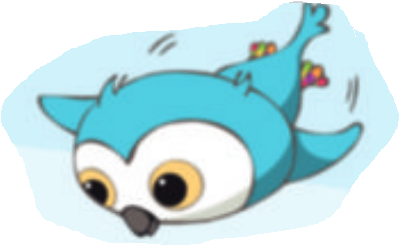
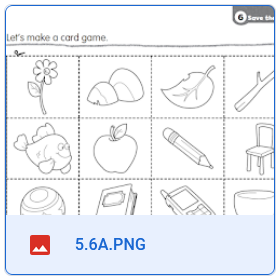
T: What’s this?
C: A (flower).
Model and practise the vocabulary several times until the children
are confident with it. Start slowly and gradually gain speed as you
point to the different items. Vary the volume and intonation of your
voice to make it fun. Then point to the pictures again and ask:
T: Is a (flower) natural or man-made?
C: (A flower is natural).
Continue with all the pictures. Hand out the crayons and tell the
children they are going to make a card game. Get them to colour
the pictures. Next, distribute construction paper, glue and scissors.
Show the children how to glue the Photocopiable Worksheet onto
the construction paper, then tell them to cut out the cards along
the dotted lines. Tell the children to write their names or initials on
the back of each card.

and explain that one is for recycling and the other is for rubbish
that cannot be recycled. Point to the pictures on the right-hand
side of the worksheet and encourage the children to describe
them.
T: What’s this? What colour is it? Is it natural or man-made?
C: (It’s a banana skin. It’s yellow. It’s natural).
Distribute crayons and tell the children to colour the pictures. Next,
give out scissors and tell the children to cut the pictures out. Say:
T: This is a (banana skin) Can we recycle this?
C: No, we can’t.
T: That’s right. Put it in the rubbish bin.
Distribute glue. Tell the children to sort the rubbish into the correct
bins by gluing the pictures on the worksheet.
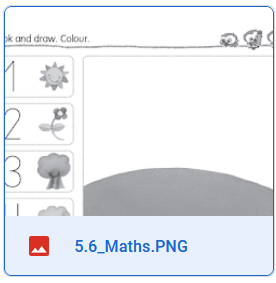
the pictures down the left-hand side. Ask:
T: How many suns are there?
C: One.
T: How many flowers are there?
C: Two.
T: How many trees are there?
C: Three.
T: How many clouds are there?
C: Four.
Tell the children to draw the correct number of items in the
picture and colour them in. Monitor and check their work.
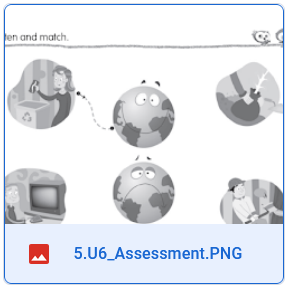
attention to the two pictures of the Earth. Ask:
T: Is the Earth happy or sad?
C: The Earth is happy.
T: How about this picture? Oh dear. Is the Earth happy or sad?
C: The Earth is sad.
Tell the children that they are going to listen and match the
pictures. Play 2.17 Unit 6 Assessment, pausing the CD at the end
of each section. Alternatively, read out the transcript.
EVALUACIÓN 2º TRIMESTRE:
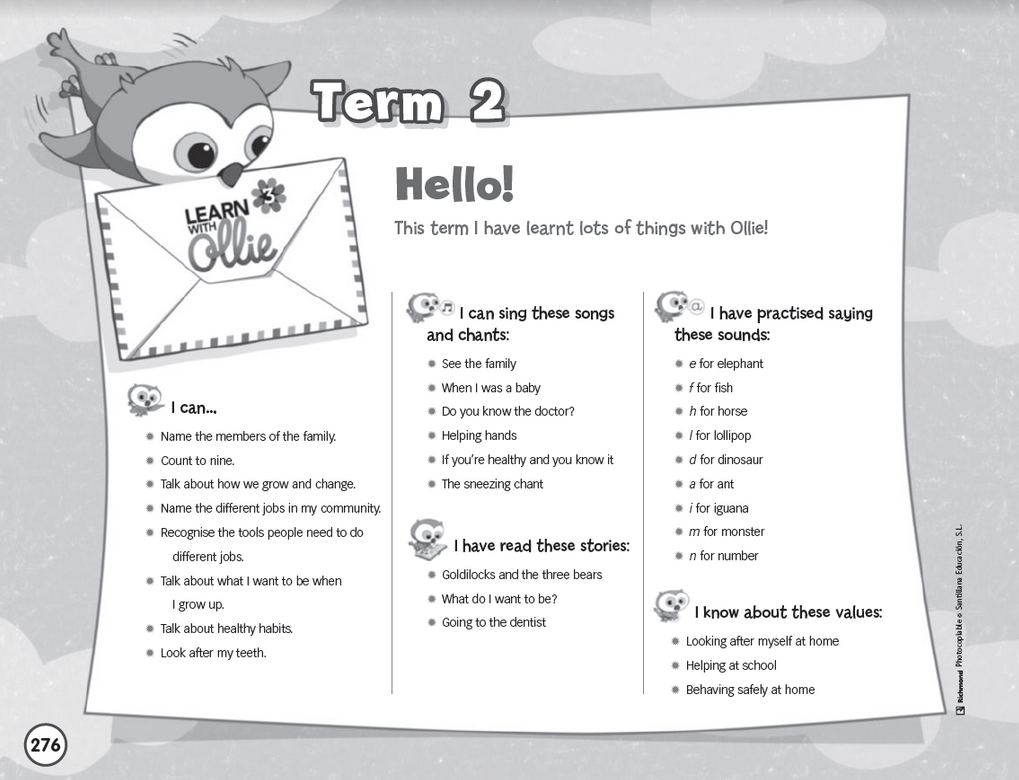

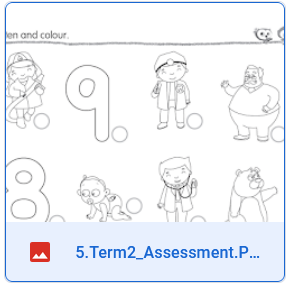
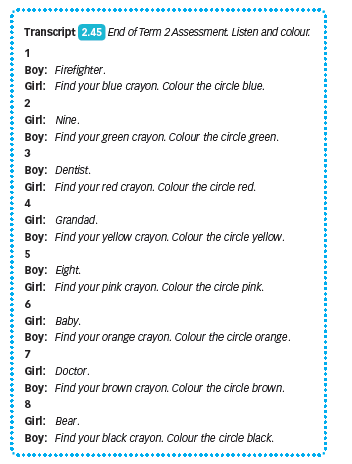
UNIT 7: MY FIVE SENSES
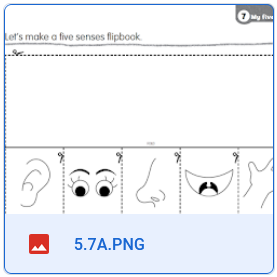
children to colour the pictures. Next, distribute scissors and show
them how to cut along the four vertical lines. When they have
finished, show them how to fold the page in half horizontally to
make the flipbook.
Distribute the materials: mini cat bells (one per child), the
Coloured Stickers, the cotton wool sprayed with baby cologne,
one sweet per child and one square of sandpaper per child. Help
the children to categorise the materials in the correct sections by
using their five senses.
When the children have categorised the materials, distribute
sticky tape and/or glue and help them to stick the materials onto
the flipbook.

salty, sour and sweet. Show the children the three plates of food
and say:
T: Crisps are salty. Lemons are sour. Sweets are sweet.
Ask the class to gather round the plates. First, tell them to try the
crisps. Ask:
T: Are the crisps salty, sour or sweet?
C: Salty.
T: Good!
Repeat with the other foods.
Read the words
together. The children trace over the words in pencil and draw
foods with the corresponding tastes. They can either draw the
foods from the lesson, or you can ask them to think of more
examples.

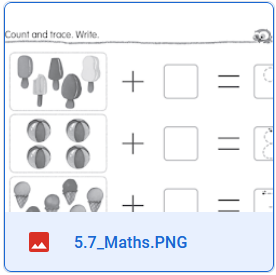
children to count the ice lollies in the first picture and trace
over the number nine. Copy the sum onto the board and ask
how many ice lollies you need to make nine. Draw four more
ice lollies in the space and count them all with the children.
T/C: Five plus four makes nine.
The children write the number four in the space in the first
box. Repeat the procedure with the other sums.
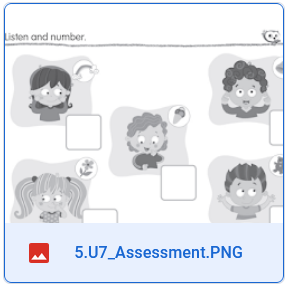
attention to the pictures of the children. Ask:
T: Is she using her (eyes)?
C: Yes.
T: How about this picture? Is he using his (nose)?
C: No. He’s using his (ears).
Tell the children to listen and number the pictures. Play 2.26 Unit
7 Assessment, pausing the CD after each speaker. Alternatively,
read out the transcript.
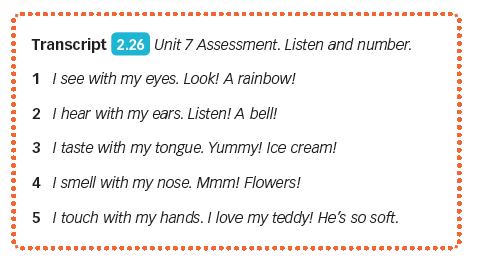
UNIT 8: GOING PLACES

the pictures. Then hand out the construction paper, glue and the
scissors. The children glue the Photocopiable Worksheet onto the
construction paper and cut the cards out. Tell the children to write
their name or their initials on the back of each card.
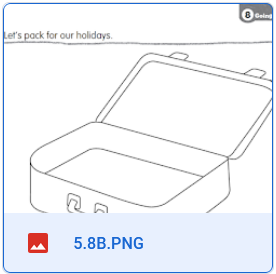
children to draw and colour things that they would pack to take on
holiday. Encourage them to decide first where they are going on
holiday,
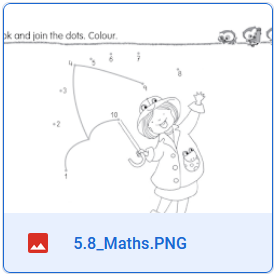
number Flashcards at random and ask the children to
shout out the numbers.
Hand out the Photocopiable Maths Worksheets. Point to
the girl in the picture. Tell the children to join the dots to
find out what she is carrying. Monitor and check their work.
When they have finished, they can colour the picture.
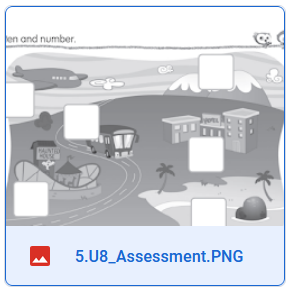
2.35 Unit 8 Assessment and pause the track after each section.
Alternatively, read out the transcript. The children listen and
number the pictures in the order they are mentioned.
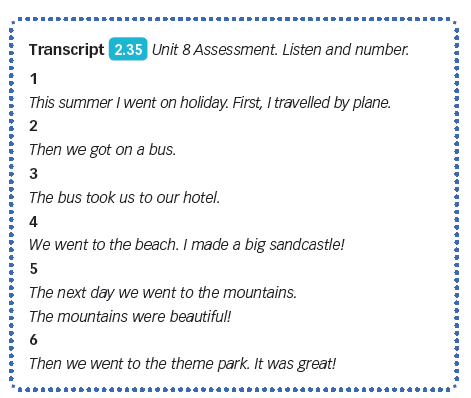
EWVALUACIÓN 3ER TRIMESTRE / FINAL:
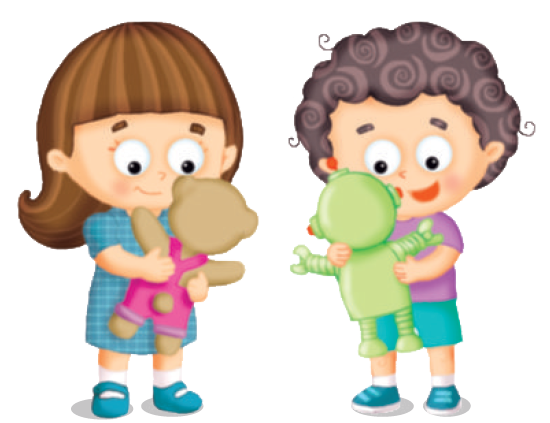
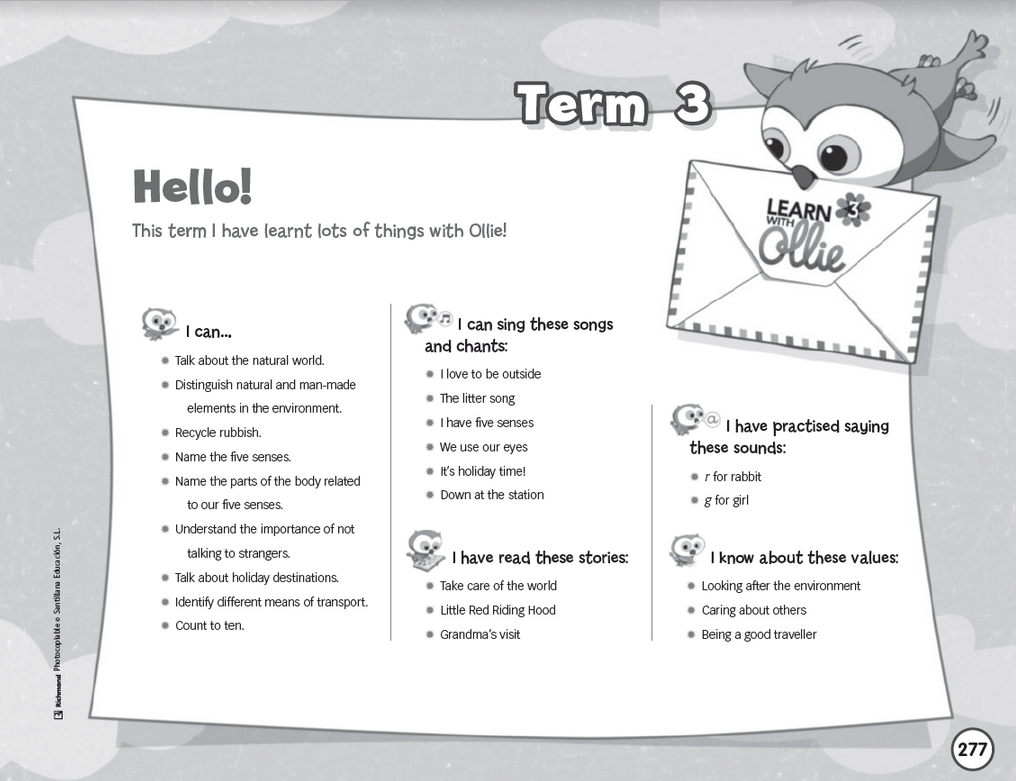

2.46 , pausing the track after each section. Alternatively, read out
the transcript. The children listen and number the pictures in the
order they are mentioned.


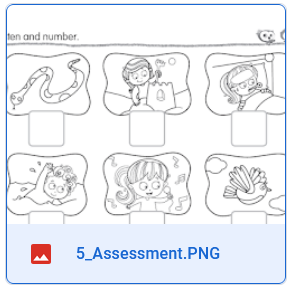
after each section. On page 270 the children listen and number the
pictures in the order they are mentioned. Then they trace, draw and
colour
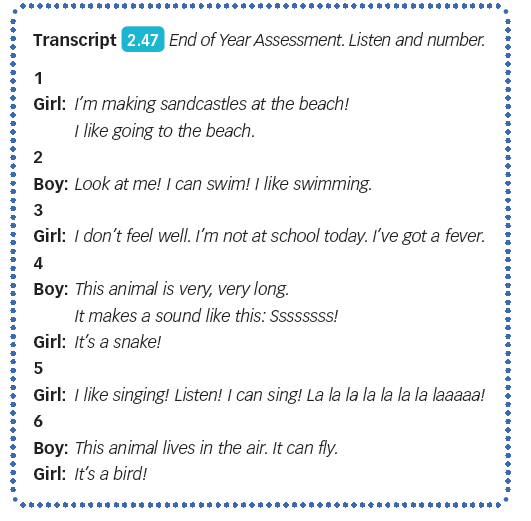
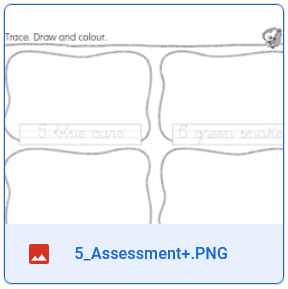

Los comentarios están cerrados aquí.